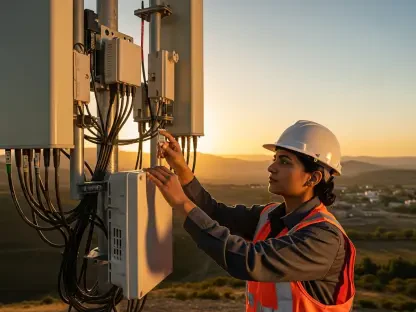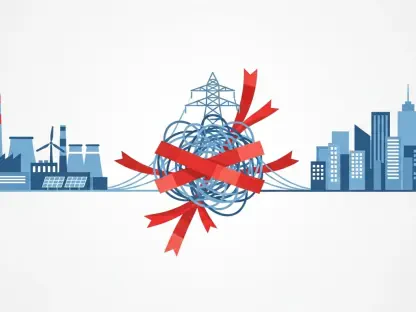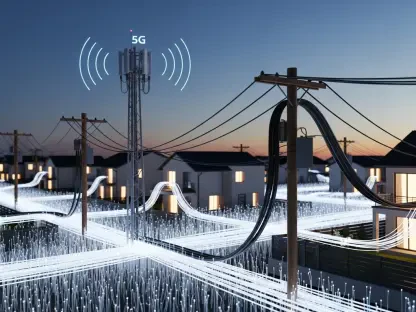Imagine a world where downloading an entire high-definition movie takes mere milliseconds, where remote surgeries are performed in real-time with zero lag, and where even the most isolated regions have access to high-speed internet. This isn’t a distant dream but a tangible reality on the horizon with 6G technology, set to transform global connectivity by the end of this decade. As the next leap beyond 5G, 6G promises to redefine how society interacts with digital systems. This roundup gathers insights, opinions, and projections from various industry perspectives to explore what 6G holds, how it builds on current innovations, and the challenges ahead in its adoption.
Exploring the Promise of 6G Through Industry Lens
The buzz around 6G is growing as standardization efforts gain momentum, with international bodies like the International Telecommunication Union (ITU) laying down frameworks for its development. Industry stakeholders view 6G as more than just an upgrade; it’s seen as a revolutionary shift that could support everything from immersive virtual reality to autonomous industrial systems. This section delves into diverse opinions on what makes 6G a game-changer, pulling from global telecom leaders, tech innovators, and regional strategies.
Different perspectives highlight a common theme: 6G is expected to deliver speeds up to 1 Terabit per second, a staggering leap from 5G’s capabilities. Many in the telecom sector emphasize that such speeds could enable applications like 3D telepresence, fundamentally changing remote collaboration. However, skepticism persists among some technology analysts who question whether infrastructure can keep pace with these ambitious targets, pointing to hurdles in spectrum allocation and hardware readiness.
Technical Breakthroughs Fueling 6G Expectations
Speed and Latency: Setting New Benchmarks
Insights from technology forums suggest that 6G could achieve latency as low as 1 microsecond, a dramatic improvement over 5G’s single-digit millisecond benchmarks. This ultra-low latency is anticipated to unlock real-time applications critical for fields like healthcare and autonomous driving. Many industry voices agree that these metrics aren’t just numbers but enablers of futuristic tools that could redefine digital interaction.
Yet, not all opinions align on feasibility. Some technical experts caution that achieving such performance requires overcoming significant barriers in signal processing and energy consumption. Discussions at recent tech summits reveal a divide, with certain factions arguing that while the potential is immense, the path to realizing these speeds remains fraught with unresolved engineering challenges.
A balanced view emerges from hardware manufacturers who stress the need for innovative materials and chip designs to support these advancements. Their input underscores a practical concern: without parallel progress in device technology, the promised speeds of 6G might remain theoretical for many users, especially in cost-sensitive markets.
Satellite Integration: Expanding Global Reach
Non-terrestrial networks (NTNs) are a hot topic among telecom providers, with many seeing satellite integration as a cornerstone of 6G’s mission to connect remote areas. Reports of trials like Device-to-Cell texting services have generated excitement, with millions expressing interest in seamless coverage beyond traditional cell towers. Proponents argue this could bridge digital divides in underserved regions.
However, cybersecurity remains a sticking point in these discussions. Some industry watchers warn that relying on satellite systems introduces vulnerabilities, from data interception to system hacks. Their concerns highlight a need for robust encryption and security protocols to protect users in a hyper-connected landscape.
On the flip side, advocates for NTN stress the transformative impact of universal access, especially for disaster-prone or isolated areas. Their perspective focuses on how 6G could ensure communication continuity, with satellite networks acting as a failsafe against terrestrial infrastructure failures, a viewpoint gaining traction in global policy circles.
AI-Driven Networks: Smarter Connectivity Solutions
The integration of artificial intelligence into 6G networks garners significant attention, with many tech leaders touting AI’s role in optimizing network management. From automating resource allocation to predicting traffic patterns, AI-native systems are expected to enhance efficiency beyond human capabilities. This optimism is particularly strong among Asian markets, where AI applications are already a focus.
Contrasting views come from some European telecom operators who question whether AI’s benefits are overhyped. They argue that while automation sounds promising, practical implementation could face hurdles like high computational costs and integration complexities. Their cautious stance calls for tempering expectations with realistic timelines.
A middle ground appears in opinions from software developers who see AI as essential but stress the importance of standardized frameworks to avoid fragmented systems. Their input suggests that for AI to truly revolutionize 6G, global collaboration on protocols and interoperability must take priority over isolated advancements.
Powering IoT and Smart City Innovations
With projections estimating 40 billion IoT devices by the decade’s end, 6G’s capacity to handle massive connectivity is a recurring theme in tech roundtables. Many urban planners and tech firms believe this will fuel smart city initiatives, from traffic management to energy efficiency. The consensus is that 6G’s spectrum efficiency offers a solution to current 5G limitations in dense environments.
Differing opinions surface on sustainability, with some environmental advocates questioning whether 6G can balance such extensive connectivity with energy conservation goals. They point to the power demands of supporting billions of devices as a potential conflict with green initiatives, urging for low-power innovations.
Meanwhile, contributions from modem developers highlight ongoing efforts to address these concerns through efficient designs that minimize energy use. Their perspective emphasizes that technological strides in chip efficiency could align 6G’s ambitious connectivity goals with environmental responsibility, a viewpoint that resonates in sustainability-focused discussions.
Strategic Insights for 6G Adoption
Diverse sources agree that preparing for 6G requires proactive steps from stakeholders across the board. Telecom giants advocate for early investments in NTN infrastructure to ensure coverage readiness, while cybersecurity experts push for integrating advanced protocols like blockchain to safeguard data. These strategic pathways are seen as critical to navigating the transition.
For businesses and consumers, recommendations include staying abreast of emerging 6G-compatible technologies and participating in pilot programs where available. Insights from market analysts suggest that early adoption of related innovations can provide a competitive edge, particularly in industries reliant on real-time data processing.
A broader consensus points to the importance of global collaboration in standardization efforts over the next few years, from 2025 onward. Many voices stress that harmonizing technical and regulatory frameworks will be key to avoiding disparities in 6G rollout, ensuring that benefits are accessible across different regions and economies.
Reflecting on the 6G Conversation
Looking back, the roundup of perspectives on 6G technology paints a vivid picture of both excitement and caution. The discussions captured a spectrum of hopes for unparalleled speed, global coverage, and intelligent systems, tempered by pragmatic concerns over technical feasibility and security risks. Each viewpoint contributed to a richer understanding of what lies ahead in telecom evolution.
Moving forward, stakeholders are encouraged to prioritize collaborative research into overcoming spectrum and energy challenges, while also investing in pilot projects to test real-world applications. Exploring partnerships for shared infrastructure development could accelerate progress, ensuring that 6G’s promise of inclusive connectivity becomes a reality for all.









